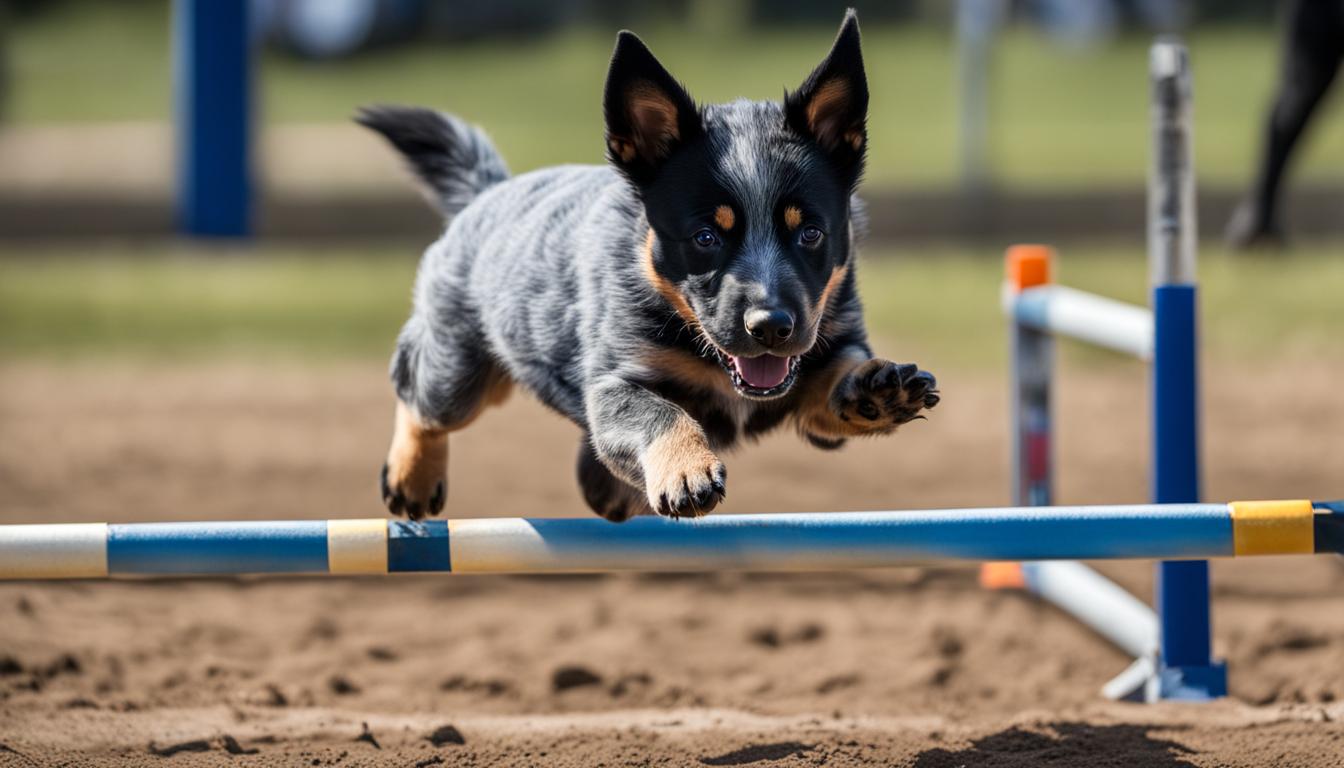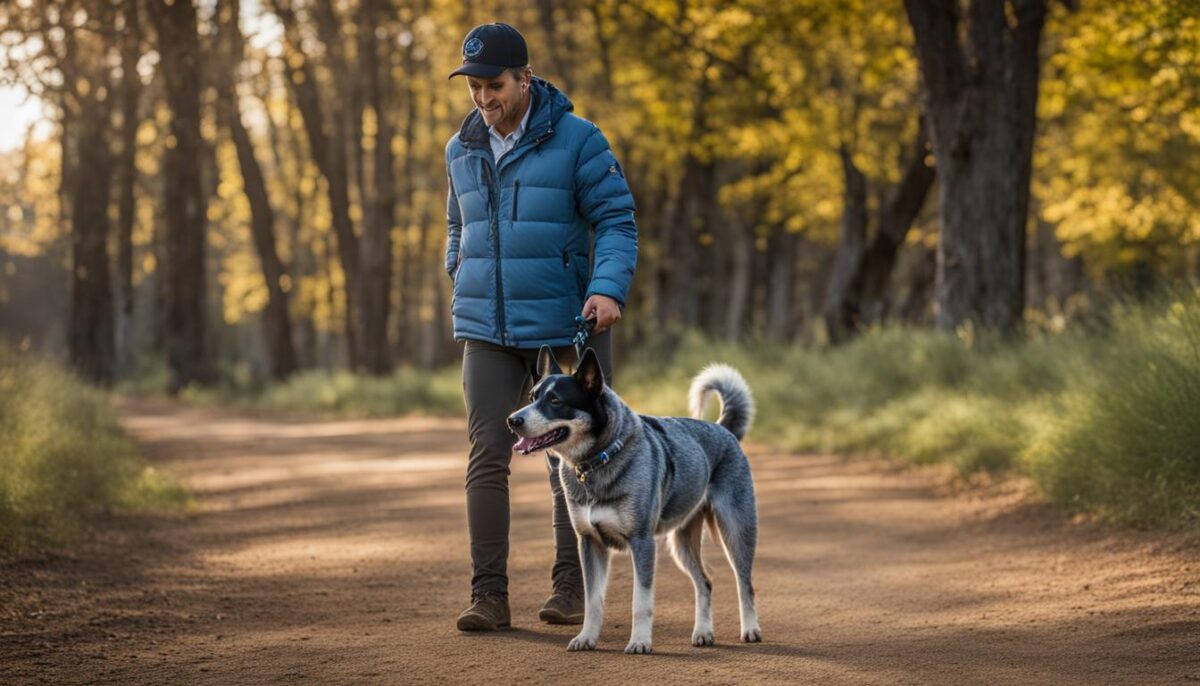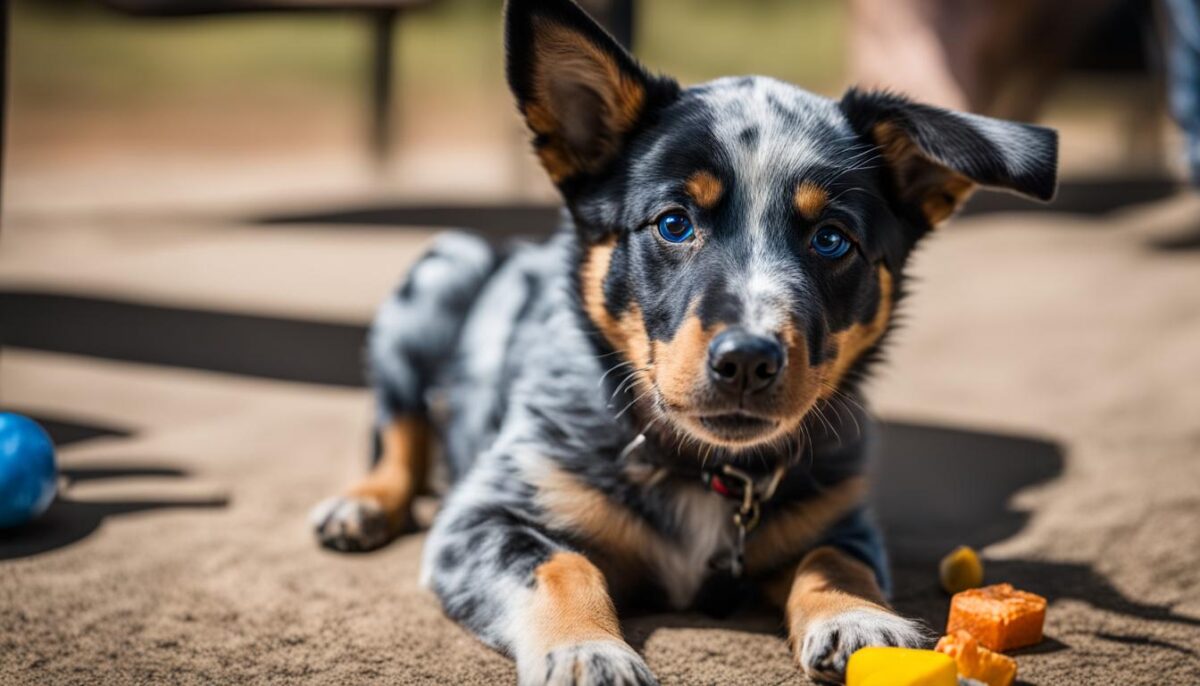If you have a Blue Heeler puppy, also called an Australian Cattle Dog, you’re in for a fun time! These dogs are smart and strong. They like to work hard and play hard. They are good at herding cattle because they are tough and can handle hot weather. Blue Heelers love their owners very much and will listen to you because they want to make you happy. But remember, training them takes some work. You need to know how to teach them in a kind way. If you do this, you’ll have a great time with your energetic and happy Blue Heeler.
To train your Blue Heeler well, you should understand what they like to do and use it to help them learn. They love to please you and do best when they are not alone. Training blue heeler puppies is a big adventure! When you teach your dog with love, they will learn blue heeler obedience fast. Learn all you can about Australian Cattle Dog training, and you both will do great!
Key Takeaways
- Blue Heelers are smart and love to work.
- They need kind training that makes them want to listen to you.
- Understanding how they think will help you teach them better.
- They like being with you and don’t like being alone much.
- Start training them when they are puppies to help them learn quickly.
- Teaching them with patience will make them happy dogs that behave well.
Understanding Your Blue Heeler’s Natural Instincts
Have you ever watched a Blue Heeler in action? These pups have a special Blue Heeler temperament that makes them super smart and full of energy. They love to move and do best with space to run and play. Living in a big house with a yard is better for them than a small apartment.
Blue Heelers, also known as Australian Cattle Dogs, are amazing for their strong herding instincts. From when they are just little pups, they love to follow their favorite person everywhere. It’s like you become their shepherd and they become your little shadow. If you understand their dog behavior, you can help them learn fun new things.
Blue Heelers like to have something to do all the time. Their minds are always looking for a puzzle to solve or a game to play!
If a Blue Heeler gets bored, they might start doing things we don’t like, such as nipping gently at our heels. It’s their way of trying to herd us! Keeping them busy with mental and physical challenges every day is the key. That way, they don’t get into any trouble.
- Long walks or runs
- Playing fetch with a ball or frisbee
- Learning new tricks
- Puzzle toys that keep their mind busy
Remember, know what makes your Blue Heeler tick, and you’ll both have a lot of fun together!
Establishing Leadership and Trust
When you are training your Blue Heeler, it’s super important to show you are the leader. This helps your dog understand how to act and listen. Dog training leadership isn’t about being mean; it’s about being kind and fair so your dog feels safe and knows you’re in charge.
One way to show you’re the leader is by controlling when your dog eats. If you eat a little before your dog and sometimes hand feed them, it helps them see you as the one who decides about food. This makes your dog more obedient because they trust you to take care of their needs.
Using a leash is another great tool. It keeps your cute Blue Heeler close to you and teaches them to follow your direction. This is part of canine trust building because it shows you will keep them safe while exploring the world together.
When you’re training, try to get your dog to look into your eyes. This isn’t just about teaching tricks; it’s about making sure they really notice you. When they watch you, it’s easier for them to learn and listen, and it helps you build a strong bond of Blue Heeler obedience.
Remember, your Blue Heeler is super smart and loves to learn! Just be patient and keep training fun. Before you know it, your Blue Heeler will be following your lead and you both will have that special trust that makes everything more fun!
How to Train a Blue Heeler Dog
When it comes to training your Blue Heeler, you’ll find positive reinforcement to be a game-changer. This method involves giving your dog a treat or a happy “Good dog!” whenever they do something right. It’s like giving them a high five for being awesome. Training your smart Blue Heeler can start pretty early, even when they’re just little pups at eight weeks old. You’ll want to be super consistent with your rules, so your Blue Heeler doesn’t get mixed signals. Let’s make sure they know who’s boss in a kind and fair way!
The Basics of Positive Reinforcement
Imagine getting a gold star every time you did your homework well. That’s how your Blue Heeler feels with positive reinforcement! Every time your furry friend does something good, like sitting or coming when called, they get a tasty treat or a joyful playtime. This way, they’ll know they did something right and will want to do it more!
Essential Commands Every Blue Heeler Should Know
All dogs need to know some super important commands that can help them behave and stay safe. Your Blue Heeler is super smart, so they’ll catch on quickly. But remember, it’s not just about one person being the trainer. Get the whole family involved so your dog knows that everyone is part of the pack.
| Command | Why It’s Important | How to Reward |
|---|---|---|
| Sit | Helps your dog stay calm and in one spot. | Give them a treat and a pat. |
| Stay | Keeps them safe when they need to wait. | Use happy words and cuddles. |
| Down | Useful for when they need to lie down and relax. | Show them some love with their favorite toy. |
| Recall (Come) | Super important for keeping them out of trouble. | A fun game of fetch as a reward works great. |
| No | Stops them from doing something they shouldn’t. | Positive attention when they listen and stop. |
As you teach your Blue Heeler these commands, you’re not just training them to be obedient, but also ensuring their dog safety. Whether at home or out on an adventure, knowing these commands can keep your dog out of harm’s way. So, grab some treats, gather the family, and let’s teach your Blue Heeler some super helpful commands!
Techniques to Curb Herding Behavior
If you have a Blue Heeler, you know they love to herd. It’s in their blood! Sometimes, though, this means they might try to herd you or your friends by nipping. But don’t worry, there are fun and easy ways to manage herding behavior in your furry friend.
Imagine your Blue Heeler is like a superhero. Their power is herding, but they need to learn how to use it in the right way. This means teaching them when it’s okay to nip and herd, and when it’s not. The trick is to be patient and make learning a game. They’ll have so much fun, they won’t even realize they’re learning!
- Ignoring the nipping: When your Blue Heeler nips at you, act like nothing happened. Just walk away. This teaches them that nipping won’t get your attention.
- Redirecting to toys: If they start to nip, give them a toy instead. It’s like saying, “Here, play with this, not my hand.”
- Drop it: This command is like a magical spell. When you say “drop it,” your Blue Heeler will learn to let go of whatever they have, even your pant leg!
The secret is to start early. When they’re young, Blue Heelers are like sponges, soaking up everything you teach them. This is the perfect time to teach them the right way to behave. And remember, never get mad at your Blue Heeler. They’re learning, just like you did when you were little. Be their guide and their best friend, and they’ll follow your lead.
Check out the table below to see some cool dog training techniques to help you and your Blue Heeler have a happy, nip-free life together.
| Technique | Why It Works | How to Do It |
|---|---|---|
| Ignoring | Takes away the attention they seek from nipping | Walk away calmly, no talking or looking |
| Toy Redirection | Gives them an appropriate outlet for their herding instinct | Offer a chew toy or tug rope instead of your hand |
| Drop It Command | Teaches impulse control and obedience | Use a treat to encourage them to let go and praise them when they do |
“Drop it” can be a fun game. Try holding a toy and playing tug-of-war. Then say “drop it” and offer a treat when they let go. Pretty soon, they’ll be dropping anything you ask them to. No more nipping!
Training your Blue Heeler can be as easy as pie. Just remember, be consistent with your rules and give lots of love and praise. You’ll have a well-behaved pup in no time. And if your Blue Heeler ever forgets and tries to nip, just remind them of the game. With your guidance, they’ll be the very best herding hero they can be, without the nipping!
Socialization Strategies for a Well-Rounded Pup
When you have a cute Blue Heeler puppy, it’s important to help them learn about the world. This is called puppy socialization. It helps them grow up to be friendly dogs who know how to act around other pets and people, especially kids. Let’s find out how to do this in a fun and safe way!
Introducing Your Blue Heeler to New Experiences
Think of every new thing your puppy meets as a chance to make a new friend. This can be new places, new sounds, and even new games! Just remember, if your Blue Heeler seems scared, go slow and give lots of praise and treats for being brave. This helps build their canine social skills.
Playing Well: Interactions with Children and Other Pets
Blue Heelers can be great pals for kids and other pets. Teach kids to be gentle, and always watch when they’re together to keep everyone safe. Introduce your pup to other pets slowly and give treats so they see new furry friends make good things happen!
| Social Situation | What to Do |
|---|---|
| Meeting New People | Let your Blue Heeler sniff and give treats for calm behavior. |
| Playing with Kids | Show kids how to pet gently and not to pull tails or ears. |
| Seeing Other Animals | Keep your pup on a leash and give treats for not chasing. |
By helping your Blue Heeler learn these social behaviors, you’re making sure they get along with everyone. This makes adventures with your pup even more fun. Remember, each new thing they learn helps make your Blue Heeler a happy and polite member of the family!
High-Energy Blue Heelers: Physical and Mental Exercise
Blue Heelers are dogs full of energy and they need fun ways to use it all up! Just like you enjoy playing games and running around, these dogs love it too. So, it’s important to find activities that keep them moving and thinking. This way, their bodies and brains stay fit and they don’t get into trouble from being bored.
Finding the Right Activity for Your Dog
Every Blue Heeler is special, and they’re going to love certain games more than others. Some might go wild for a good game of fetch, while others may like jumping over obstacles on an agility course. There are plenty of high-energy dog activities to try out with your pup. You can even get them into engaging dog sports like flyball or disc dog competitions. And for a good mix of running and thinking, Treibball is a super fun ball-herding sport they might love. Try different things and see what makes your Blue Heeler’s tail wag the most!
Engaging Toys and Games for Mental Stimulation
But hey, Blue Heelers need to use their brains too! Mental stimulation for dogs is just as important as running and jumping. Interactive dog toys like puzzle feeders make your pup work a bit to get their treats. It’s like a fun game where they have to think hard to solve the puzzle. And there are cool canine brain games you can play with your dog, like hide-and-seek, where you hide their favorite toy and they have to figure out where it is. It’s a blast for both of you and it keeps their mind sharp!
Remember, keeping your Blue Heeler busy and happy is all about trying lots of activities and games. It might take some time to figure out what they love, but when you see them having fun, it’s totally worth it!
Conclusion
Embarking on comprehensive Blue Heeler training is a journey as lively and engaging as the breed itself. To foster successful dog training, you’re encouraged to dive deep into understanding your furry friend’s natural wants and ways. Remember, they are built for action and cleverness, so your Blue Heeler will need both your heart and mind fully committed to their learning.
Your leadership sets the stage for trust and shapes a Blue Heeler that listens and thrives. With positive reinforcement, you turn their energy into good behavior, guiding them away from herding the kids or the family cat. Living well together means easing them into social circles from pups to full-grown dogs, so they know how to behave around both new people and pets.
Games, runs, and a good challenge keep your Blue Heeler’s mind and body in top shape. This is no sit-and-stay kind of pup—they want action, and your job is to guide that gusto! Stay patient, stay consistent, and you’ll see your Blue Heeler grow from a spunky little learner to a smart, loyal companion who’s a joy to have in your family.
FAQ
What basic commands should my Blue Heeler learn during training?
Your Blue Heeler should learn essential commands like sit, stay, down, and recall. These commands are the foundation of good behavior and are crucial for your dog’s safety in various situations. Additionally, ‘no’ is important to teach them to stop unwanted behaviors.
How can I effectively manage my Blue Heeler’s herding instincts?
To manage your Blue Heeler’s herding instincts, you can use techniques like redirecting their attention to toys, ignoring the nipping behavior, and teaching commands that promote dropping objects or ceasing specific actions. Early intervention is key to curbing unwanted herding behaviors like nipping.
Why is socialization important for my Blue Heeler puppy, and how do I do it?
Socialization is vital for your Blue Heeler’s development, helping them to become well-adjusted adults. Introduce them to a variety of experiences, environments, people, and other animals in a positive and controlled manner. Always praise and reward your puppy for brave behavior in new situations.
What are some high-energy activities suitable for my Blue Heeler?
Blue Heelers thrive on vigorous physical and mental activity. Suitable activities include herding activities, agility courses, and dog sports like Treibball. These activities cater to their energetic nature and provide them with the physical exercise they need.
How can I keep my Blue Heeler mentally stimulated?
Keeping your Blue Heeler mentally stimulated involves offering a variety of games and puzzles that challenge their intellect. Interactive toys, obedience training exercises, and mentally-stimulating puzzles can help prevent boredom and encourage desirable behavior.
When should I start training my Blue Heeler puppy?
You can start training your Blue Heeler puppy as early as eight weeks old. Begin with simple commands and gradually build up to more complex training routines as they grow. Early training helps in shaping their behavior and instilling good habits from the start.
Can Blue Heelers live in apartments?
Blue Heelers are not typically suited for apartment living due to their high-energy levels and need for space to run and engage in physical activities. They are best suited for homes with yards or access to open spaces for daily exercise.
How do I deal with my Blue Heeler’s separation anxiety?
To address separation anxiety, you can create a comforting environment with familiar toys and bedding. Practice leaving and returning for short periods, gradually increasing the time, and always remain calm during departures and reunions. Training your Blue Heeler to associate your departure with positive experiences can also be beneficial.
What are the benefits of positive reinforcement in Blue Heeler training?
Positive reinforcement strengthens the bond between you and your Blue Heeler and encourages them to repeat good behavior. Immediate rewards after desirable actions help your dog make positive connections with obeying commands and acting appropriately.
How do Blue Heelers interact with children and other pets?
Blue Heelers can interact well with children and other pets if introduced carefully and socialized from an early age. Teach your Blue Heeler appropriate behaviors around children to prevent accidental harm and supervise their interactions. Early socialization can also facilitate good relationships with other family pets.


